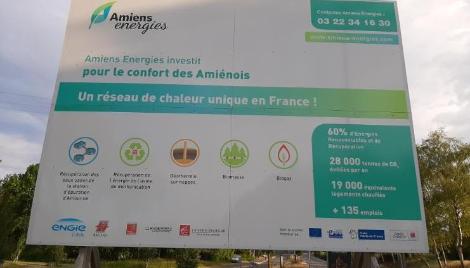Amiens: an innovative urban heating network
janvier 2025
Territoires à Energie Positive (TEPOS)
The city has been developing its urban heating network since 2017. Supplied by five sources of renewable and recovered energy, this network distributes heat to apartment buildings and service sector establishments.
key element of the region’s ecological transition strategy.
‘Today, the Amiens heating network is 75 km long, has 350 subscribers and avoids 41,000 tonnes of CO2 every year,’ says Vincent Pibouleu, department manager at Engie and CEO of Amiens Energie. The first semi-public company (SEMOP) in the energy sector in France, Amiens Energie was set up at the initiative of the city to build this heating network, 60% of which is powered by renewable energy, and to operate it for 25 years. This structure aims to facilitate the management of the public urban heating service. SEMOP is 51% owned by Engie Solutions, 34% by the city and 15% by the Banque des Territoires. ‘We benefit from Engie’s infrastructure, which assists us in management, legal matters, purchasing and technical matters,’ he explains.

A virtuous network
The Amiens heating network is based on a diversified energy mix of local renewable energies: ‘energy recovery from wastewater at the treatment plant, biomass, geothermal energy from groundwater, biogas and heat recovery from cogeneration units (heat and electricity).’ 8.5 million m3 of wastewater is treated in this way every year. Six heat pumps make it possible to recover the energy. Among the projects currently underway to extend the network is the interconnection of the second industrial water treatment plant to the existing heat pumps. ‘We are trying to make the recovery fatal,’ explains Vincent Pibouleu. In other words, this excess energy is captured to be integrated into the network. After the Vauvoix biomass boiler plant, a second 14 MW boiler plant is under construction in the south of the city. The aim is to run it on 30% green waste and connect the university hospital to it in the summer of 2025. Amiens will then have ten production plants spread across its territory. A geothermal cooling network is also being rolled out in the new Gare la Vallée urban development zone. It will supply seven service sector buildings. Nearly 140 million euros have been invested in the creation and roll-out of this district heating network, creating 1,500 jobs since 2018 (in construction and equipment supply).
Breaking free from dependence on fossil fuels
In the city centre, this network supplies the university hospital annex, the Victor Pauchet clinic, the Polyclinique de l’Europe and 26,800 homes (co-owned properties and social housing). ‘The local authority recovers more than 750,000 euros in fees for occupying the public domain,’ he says. This income is reinvested in the thermal renovation of housing for homes that cannot be connected to the network. This is the case for the amiénoises, the typical brick houses. The network extension work is scheduled for completion in 2026. ‘When everything is up and running, we will be using barely 8 to 10% gas,’ says Vincent Pibouleu. We are three-quarters of the way towards achieving the energy autonomy set for 2050 by our elected representatives.’